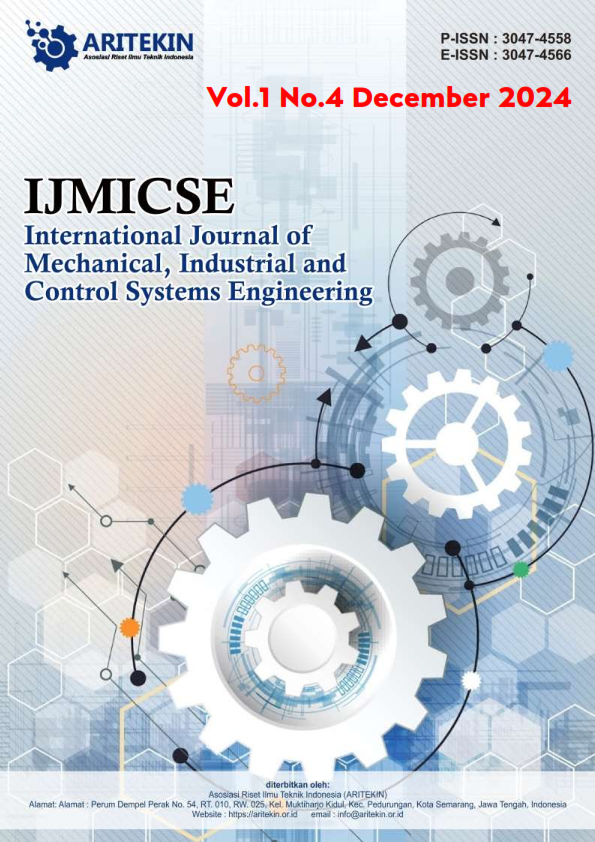Welding Quality Control Using The Sqc (Statistical Quality Control) Method In An Effort To Minimize The Occurrence Of Rejects At Pt.Xyz
DOI:
https://doi.org/10.61132/ijmicse.v1i4.125Keywords:
Defect, Quality Control, Statistical Quality Control (SQC), WeldingAbstract
PT. XYZ is an international company operating in the energy sector, especially oil and gas, with a focus on fabrication and construction activities for large-scale projects. One of the main production processes that is very influential is welding. To ensure welding quality, PT. XYZ uses the Non-Destructive Testing – Ultrasonic Testing (NDT-UT) method. However, during the inspection process, problems are often found in the form of rejects due to defects that do not meet welding quality standards. Some types of defects detected include LOF (Lack of Fusion), LOP (Lack of Penetration), and ESI (Excessive Spatter Inclusion). This research aims to determine the percentage of the most dominant welding defects, identify factors that cause defects, and provide recommendations for improvements to improve welding quality. The method used is Statistical Quality Control (SQC) with the help of tools such as check sheets, histograms, Pareto diagrams, scatter diagrams, control charts and fishbone diagrams. Based on the data collected, a LOF defect of 5,434 mm was found, an ESI defect of 1,990 mm, and an LOP defect of 1,030 mm. SQC analysis shows that the dominant defect is LOF with a percentage of 64%. The main causal factors come from methods, humans, machines and materials. Therefore, companies need to make improvements and developments to reduce product defects so that they can improve welding quality.
References
Fatah, A., & Al-Faritsy, A. Z. (2021). Product quality improvement and control using PDCA method (case study at PT. “X”). Journal of Industrial Engineering (JRI), 3(1), 21–30.
Hendrawan, D., Wirawati, S. M., & Wijaya, H. (2020). Quality control analysis in the wagyu beef boning process using statistical quality control (SQC) at PT. Santosa Agrindo. Journal Industrial Engineering & Management Research (JIEMAR), 1(2), 195–206.
Lestari, F. A., & Purwatmini, N. (2021). Textile product quality control using DMAIC method. Ecodemica Journal: Journal of Economics, Management, and Business, 5(1), 79–85.
Mubarok, M. Z., & Machfuroh, T. (2024). Welding quality control of SS400 steel for ducting at PT. XYZ with SQC method. G-Tech: Journal of Applied Technology, 8(4), 2178–2189.
Nazia, S., Fuad, M., & Safrizal. (2023). The role of statistical quality control (SQC) in quality control: Literature study. Samudra Accounting Student Journal, 4(3), 125–138.
Oktavia, A., & Herwanto, D. (2021). Analysis of product quality control using statistical quality control (SQC) approach at PT. Samcon. Innovative Industry - Journal of Industrial Engineering ITN Malang, 11(2), 106–113.
Putra, R. F. W., & Wardani, I. P. (2023). The effect of couplant variation on ultrasonic testing on thickness testing of SS304 and PVC materials. Proceedings of the III National Seminar on Sustainable Industrial Technology, 3, 1–6.
Saputra, A. D., & Nugroho, A. J. (2023). Analysis of leather tanning product quality using SQC and FMEA methods. JURITEK Scientific Journal of Mechanical, Electrical and Computer Engineering, 3(2), 150–164.
Supardi, & Dharmanto, A. (2020). Statistical analysis of quality control in controlling the quality of culinary products of Ayam Geprek at BFC, Bekasi City. Scientific Journal of Management Faculty of Economics, 6(2), 199–210.
Yunianto, B., & Wicaksana, P. (2023). Welding defect analysis on ASTM A106 grade B pipes using magnetic particle test and liquid penetrant test at the welding and inspection workshop of PPSDM Migas Cepu. Journal Rotation, 25(2), 54–60.
Downloads
Published
How to Cite
Issue
Section
License
Copyright (c) 2024 International Journal of Mechanical, Industrial and Control Systems Engineering

This work is licensed under a Creative Commons Attribution-ShareAlike 4.0 International License.





